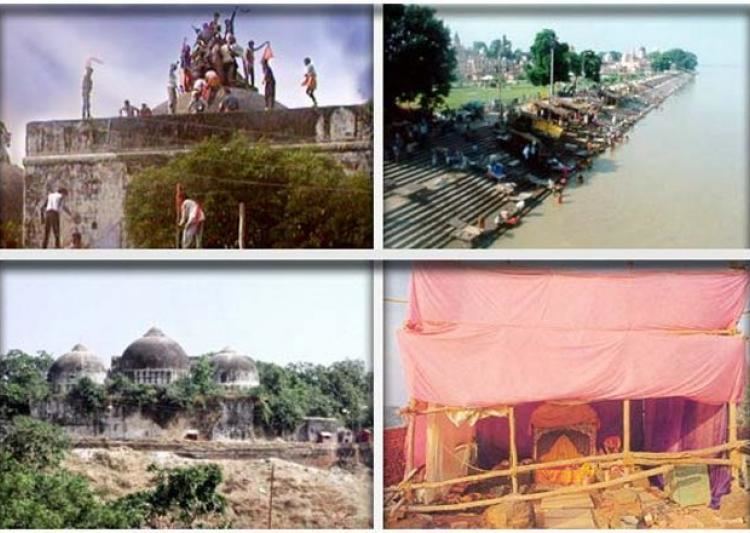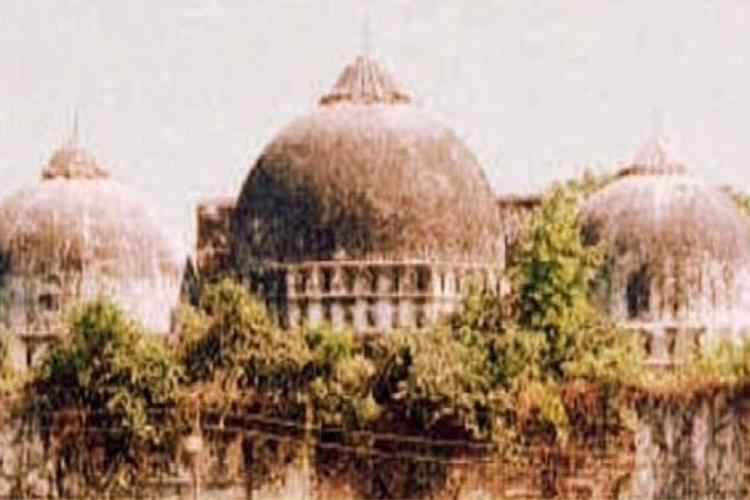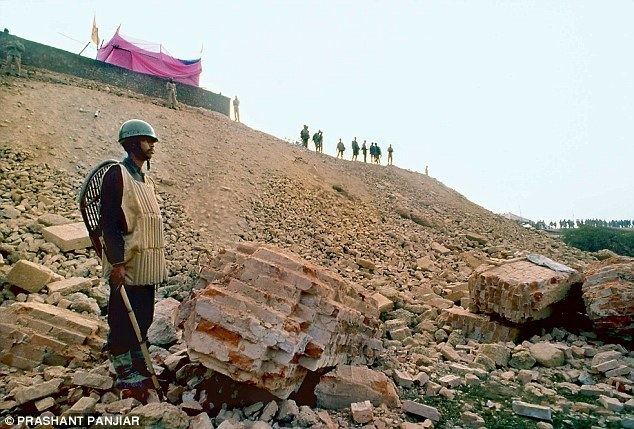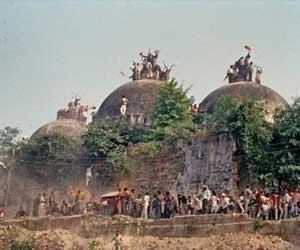Ownership Disputed | ||
 | ||
Similar Babri Masjid, Hanumangarhi, Ayodhya Junction railway st, Prem Mandir Vrindavan, Kashi Vishwanath Temple | ||
Exclusive what keeps ram janmabhoomi babri masjid dispute still unresolved
Ram Janmabhoomi (literally, "Rama's birthplace") is the name given to the site that is believed to be the birthplace of Rama, the 7th avatar of the Hindu deity Vishnu.
Contents
- Exclusive what keeps ram janmabhoomi babri masjid dispute still unresolved
- Babri Masjid site
- Opposition to the claim
- Proposed Ram Janmabhoomi temple
- Other places
- References

The Ramayana states that the location of Rama's birthplace is on the banks of the Sarayu river in the city of Ayodhya. A section of Hindus claim that the exact site of Rama's birthplace is where the Babri Masjid once stood in the present-day Ayodhya, Uttar Pradesh. According to this theory, the Mughals demolished a Hindu shrine that marked the spot, and constructed a mosque in its place. People opposed to this theory state that such claims arose only in the 18th century, and that there is no evidence for the spot being the birthplace of Rama.

The political, historical and socio-religious debate over the history and location of the Babri Mosque, and whether a previous temple was demolished or modified to create it, is known as the Ayodhya dispute.

In 1992, the demolition of Babri Masjid by Hindu nationalists triggered widespread Hindu-Muslim violence. Since then, the archaeological excavations have indicated the presence of a temple beneath the mosque rubble, but whether the structure was a Rama shrine (or a temple at all) remains disputed.

Several other sites, including places in other parts of India, Afghanistan, Pakistan and Nepal, have been proposed as birthplaces of Rama.

Babri Masjid site

Ramayana, a Hindu epic whose earliest portions date back to 1st millennium BCE, states that the capital of Rama was Ayodhya. A section of Hindus claim that the site of the now-demolished Babri Mosque in Ayodhya is the exact birthplace of Rama. The mosque was constructed during 1528-29 by Mir Baqi, a commander of the Mughal emperor Babur.
The earliest extant account of the mosque's connection to the birthplace of Rama comes from the European Jesuit missionary Joseph Tiefenthaler, who visited the site during 1766-1771. Johann Bernoulli translated his account from French, and included it in his 1788 work. According to this account, either Aurangazeb or Babur had demolished the Ramkot fortress, including the house that was considered as the birthplace of Rama by Hindus. He further states that a mosque was constructed in its place, but the Hindus continued to offer prayers at a mud platform that marked the birthplace of Rama. In 1810, Francis Buchanan visited the site, and stated that the structure destroyed was a temple dedicated to Rama, not a house. Many subsequent sources state that the mosque was constructed after demolishing a temple.
Before the 1940s, the Babri Masjid was called Masjid-i-Janmasthan ("mosque of the birthplace"), including in the official documents such as revenue records. Shykh Muhammad Azamat Ali Kakorawi Nami (1811–1893) wrote: "the Babari mosque was built up in 923(?) A.H. under the patronage of Sayyid Musa Ashiqan in the Janmasthan temple in Faizabad-Avadh, which was a great place of (worship) and capital of Rama’s father"
H.R. Neville wrote that the Janmasthan temple "was destroyed by Babur and replaced by a mosque." He also wrote "The Janmasthan was in Ramkot and marked the birthplace of Rama. In 1528 A.D. Babur came to Ayodhya and halted here for a week. He destroyed the ancient temple and on its site built a mosque, still known as Babur's mosque. The materials of the old structure [i.e., the temple] were largely employed, and many of the columns were in good preservation."
Opposition to the claim
A section of historians, such as R. S. Sharma, state that such claims of Babri Masjid site being the birthplace of Rama sprang up only after the 18th century. Sharma states that Ayodhya emerged as a place of Hindu pilgrimage only in medieval times, since ancient texts do not mention it as a pilgrim centre. For example, chapter 85 of the Vishnu Smriti lists 52 places of pilgrimage, which do not include Ayodhya. Sharma also notes that Tulsidas, who wrote the Ramcharitmanas in 1574 at Ayodhya, does not mention it as a place of pilgrimage. Rambhadracharya, on the other hand, has quoted a work of Tulsidas known as Dohā Śataka and is recorded in Allahbad High Court's verdict which clearly states the demolition of a temple, and building of a mosque.
Many critics also claim that the present-day Ayodhya was originally a Buddhist site, based on its identification with Saketa described in Buddhist texts. According to historian Romila Thapar, ignoring the Hindu mythological accounts, the first historic mention of the city dates back to the 7th century, when the Chinese pilgrim Xuanzang described it as a Buddhist site.
Proposed Ram Janmabhoomi temple
In 1853, a group of armed Hindu ascetics belonging to the Nirmohi Akhara occupied the Babri Masjid site, and claimed ownership of the structure. Subsequently, the civil administration stepped in, and in 1855, divided the mosque premises into two parts: one for Hindus, and the other for Muslims.
In 1883, the Hindus launched an effort to construct a temple on the platform. When the administration denied them the permission to do this, they took the matter to court. In 1885, the Hindu Sub Judge Pandit Hari Kishan Singh dismissed the lawsuit. Subsequently, the higher courts also dismissed the lawsuit in 1886, in favour of status quo. In December 1949, some Hindus placed idols of Rama and Sita in the mosque, and claimed that they had miraculously appeared there. As thousands of Hindu devotees started visiting the place, the Government declared the mosque a disputed area and locked its gates. Subsequently, multiple lawsuits from Hindus, asking for permission to convert the site into a place of worship.
In the 1980s, the Vishwa Hindu Parishad (VHP) and other Hindu nationalist groups and political parties launched a campaign to construct the Ram Janmabhoomi Mandir ("Rama birthplace temple") at the site. The Rajiv Gandhi government allowed Hindus to access the site for prayers. On 6 December 1992, Hindu nationalists demolished the mosque, resulting in communal riots leading to over 2,000 deaths.
In 2003, the Archaeological Survey of India (ASI) conducted excavations of the site on court orders. The ASI report indicated the presence of a 10th-century temple under the mosque. Muslim groups and the historians supporting them disputed these findings, and dismissed them as politically motivated. The Allahabad High Court, however, upheld the ASI's findings. In 2010, Court ruled that the 2.77 acres (1.12 ha) of Ayodhya land be divided into 3 parts, with 1/3 going to the Ram Lalla or Infant Lord Rama represented by the Hindu Maha Sabha for the construction of the Ram temple, 1/3 going to the Islamic Sunni Waqf Board and the remaining 1/3 going to a Hindu religious denomination Nirmohi Akhara. The excavations by the Archaeological Survey of India were heavily used as evidence by the court that the predating structure was a massive Hindu religious building.
In 2009, the Bharatiya Janata Party (BJP) released its election manifesto, repeating its promise to construct a temple to Rama at the site.
Other places
Those who believe that Rama was a historic figure place his birth before 1000 BCE. However, the archaeological excavations at Ayodhya have not revealed any settlement before that date. Consequently, a number of other places have been suggested as the birthplace of Rama.
In November 1990, the newly appointed Prime Minister Chandra Shekhar made an attempt to resolve the Ayodhya dispute amicably. Towards this objective, he asked Hindu and Muslim groups to exchange evidence on their claims over Ayodhya. The panel representing the Muslim organization Babri Masjid Action Committee (BMAC) was included R. S. Sharma, D. N. Jha, M. Athar Ali and Suraj Bhan. The evidence presented by them included scholarly articles discussing alternative theories about the birthplace of Rama. These sources mentioned 8 different possible birthplaces, including a site other than Babri Masjid in Ayodhya, Nepal and Afghanistan. One source claimed that Rama was a pharaoh of ancient Egypt.
In his 1992 book Ancient geography of Ayodhya, historian Shyam Narain Pande argued that Rama was born around present-day Herat in Afghanistan. In 1997, Pande presented his theory in the paper "Historical Rama distinguished from God Rama" at the 58th session of the Indian History Congress in Bangalore. In 2000, Rajesh Kochhar similarly traced the birthplace of Rama to Afghanistan, in his book The Vedic People: Their History and Geography. According to him, the Harriud river of Afghanistan is the original "Sarayu", and Ayodhya was located on its banks.
In 1998, archaeologist Krishna Rao put forward his hypothesis about Banawali being Rama's birthplace. Banawali is an Indus-Sarasvati civilization archaeological site located in the Haryana state of India. Rao identified Rama with the Sumerian king Rim-Sin I and his rival Ravana with the Babylonian king Hammurabi. He claimed to have deciphered Indus seals found along the Sarasvati rivers, and found the words "Rama Sena" (Rim-Sin) and "Ravani dama" on those seals. He rejected Ayodhya as the birthplace of Rama, on the grounds that Ayodhya and other Ramayana sites excavated by B. B. Lal do not show evidence of settlements before 1000 BCE. He also claimed that the writers of the later epics and the Puranas got confused because the ancient Indo-Aryans applied their ancient place names to the new place names as they migrated eastwards.
In 2015, Abdul Rahim Quraishi of the All India Muslim Personal Law Board (AIMPLB), argued that Rama was born somewhere in present-day northwestern India or Pakistan. In his book Facts of Ayodhya Episode (Myth of Ram Janmabhoomi), he cited writings of former ASI official Jassu Ram, who argued that Rehman Dheri was the birthplace of Rama. Rehman Dheri is located near Dera Ismail Khan in present-day Pakistan, and was earlier called "Ram Dheri" according to Jassu Ram. Quraishi argued that the present-day Ayodhya was originally called Saket, and Hindus probably renamed it to "Ayodhya" in the 11th century CE.
